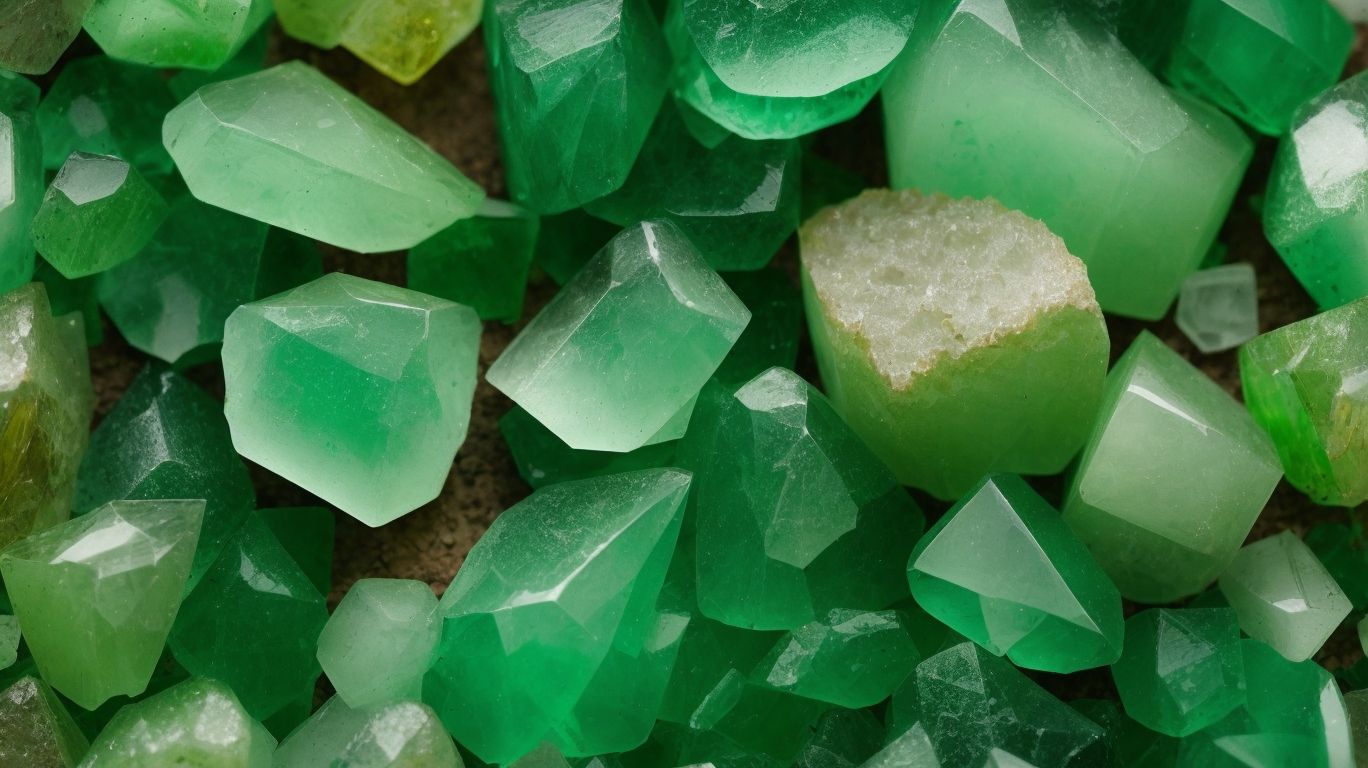
Calcite’s Earthy Wonders: Discovering Green Calcite Crystals
In the realm of Earth’s geological treasures, few minerals capture the imagination quite like calcite. Its multifaceted nature offers a myriad of physical properties, from its crystal structure to color variations and hardness. But beyond its scientific allure, calcite holds a place in both industrial and metaphysical realms, with applications in various industries and a reputation for healing and spiritual significance.
Join us as we delve into the captivating world of green calcite crystals, from their physical attributes to their diverse uses and care instructions. Whether you’re a geology enthusiast, a crystal collector, or simply curious about the wonders of the Earth, this exploration of calcite promises to engage and enlighten.
What is Calcite?
Calcite is a fascinating mineral known for its earthy wonders, and discovering its formations and properties can be truly captivating.
With its unique geological properties, calcite is a mineral that has intrigued scientists and enthusiasts alike. From its formation in sedimentary environments to its stunning range of colors and crystal formations, calcite holds a significant place in the world of geology. Beyond its geological significance, calcite is also revered for its metaphysical properties, believed to bring clarity and prosperity to those who connect with it. It’s truly remarkable how this mineral navigates the realms of both science and spirituality.
What Are the Physical Properties of Calcite?
The physical properties of calcite encompass a diverse range of mineralogical characteristics, from its formation to its unique properties and crystallography.
What Is the Crystal Structure of Calcite?
The crystal structure of calcite is characterized by its distinctive rhombohedral shape, reflecting its unique crystallography and internal arrangement.
It belongs to the hexagonal crystal system and is composed of calcium, carbon, and oxygen atoms arranged in a trigonal planar fashion. The internal structural characteristics of calcite include its perfect rhombohedral cleavage and its strong birefringence, making it a valuable resource for polarizing microscopes. The crystallography of calcite also plays a crucial role in its optical properties, as it exhibits double refraction when light passes through its cleavage planes. These inherent features make calcite a fascinating subject for researchers and enthusiasts studying mineralogy and crystal structures.
What Is the Hardness of Calcite?
The hardness of calcite, as determined by its cleavage and mineralogical attributes, contributes to its overall geological significance and practical applications.
Its distinct cleavage properties, characterized by its perfect rhombohedral cleavage, result in its unique ability to break along specific planes, giving it a practical application in various industrial processes. Composed primarily of calcium carbonate, calcite’s mineralogical composition further influences its hardness, making it a valuable mineral in fields such as construction and metallurgy.
Its geological significance lies in its widespread presence as a major constituent in limestone and marble formations, shaping the Earth’s surface and impacting geological processes.
What Are the Color Variations of Calcite?
Calcite exhibits remarkable color variations, from translucent to transparent hues, reflecting its optical properties and geological significance.
These variations result from the presence of trace elements within the crystal lattice, influencing its light transmission and color. The translucent forms often showcase vibrant colors, such as pink, green, or blue, while the transparent variants may exhibit a brilliant rainbow effect known as double refraction. This optical phenomenon, along with its birefringence, makes calcite a captivating mineral for both scientific study and ornamental use in jewelry and decor.
Where Can You Find Calcite?
Calcite can be found in various geological formations and occurrences, offering enthusiasts and researchers an exciting journey of discovering its natural habitats.
Exploring caves, limestone deposits, and geodes can lead to awe-inspiring encounters with calcite crystals, showcasing the diverse environments in which this mineral thrives. Whether it’s within sedimentary rocks, hydrothermal veins, or as a product of biological processes, the discovery of calcite in its natural settings provides valuable insights into Earth’s geological history and processes.
What Are the Top Locations for Calcite?
Some of the top locations for finding calcite include sedimentary formations and limestone deposits, showcasing its widespread occurrence in nature.
These formations can be found in various regions across the world, from the famous White Cliffs of Dover in the UK to the iconic limestone caves in Carlsbad Caverns, New Mexico.
The presence of calcite in these geological marvels underscores its significance in shaping the Earth’s landscape and serving as a key constituent of many natural structures.
What Are the Other Common Places to Find Calcite?
Besides sedimentary settings, calcite can also be commonly found in spectacular formations, offering enthusiasts diverse opportunities for exploration and discovery.
These formations can be spotted in caves, where calcite stalactites and stalagmites create breathtaking displays. Calcite’s presence in geodes and crystalline structures contributes to the allure of natural caves and rock formations. In mining regions, magnificent calcite crystals are often uncovered, adding to the wonder of geological exploration.
The spectacular presence of calcite is evident in coral reefs, where it contributes to the intricate and colorful formations that support diverse marine life.
What Are the Uses of Calcite?
Calcite serves a multitude of purposes, from industrial applications to spiritual healing and metaphysical energy enhancement, making it a versatile and sought-after mineral.
Its industrial uses are extensive, with calcite being a key component in the manufacturing of cement, glass, and lime. Its ability to enhance clarity and amplify energy makes it highly prized in spiritual practices and crystal healing. Calcite is believed to cleanse and energize the chakras, promote inner peace, and alleviate emotional stress. Many also use it for its purported physical healing properties, such as aiding in bone and joint health. Its versatility and diverse benefits continue to captivate users across different domains.
What Is Calcite Used for in Industrial Applications?
In industrial applications, calcite is prized for its purity and cleansing properties, making it a valuable resource for various manufacturing processes and environmental uses.
Its exceptional purity makes it a prime choice for industries such as pharmaceuticals, where strict standards are essential. The cleansing characteristics of calcite are utilized in water treatment processes, helping to remove impurities and maintain water quality. Its environmentally friendly nature enables its use in neutralizing acidic wastewaters, contributing to sustainable industrial practices and reducing environmental impact.
What Are the Healing Properties of Calcite?
Calcite possesses remarkable healing properties, particularly in chakra alignment and energy balancing, offering a holistic approach to emotional and spiritual well-being.
Its vibrant energy resonates with the lower chakras, fostering a sense of stability and security, while also promoting openness and receptivity in the upper chakras. This helps individuals achieve a harmonious flow of energy throughout the body, addressing emotional imbalances and facilitating a deeper connection to their spiritual essence.
What Are the Spiritual Meanings of Calcite?
The spiritual meanings of calcite are deeply rooted in its transformative and manifestation-enhancing qualities, fostering a sense of abundance and rejuvenation in spiritual practices.
Its vibrant energy encourages inner exploration and growth, supporting the emergence of new perspectives and spiritual insights. Calcite is believed to amplify one’s intentions, aiding in the manifestation of desires and goals during meditative practices. Its association with the solar plexus chakra facilitates a sense of empowerment and self-confidence, allowing individuals to embrace their true potential.
Incorporating calcite into spiritual rituals can bring clarity and emotional balance, promoting spiritual growth and inner rejuvenation.
How Do You Care for Calcite Crystals?
Caring for calcite crystals involves mindful cleansing and chakra alignment practices, ensuring their optimal energy flow and metaphysical benefits.
When it comes to cleansing calcite crystals, it’s important to take a gentle approach. Using lukewarm water and a mild soap, carefully clean the surface to avoid any damage.
Chakra alignment can be achieved by placing calcite near the corresponding energy centers of the body, promoting balance and harmony. By incorporating these mindful practices, you can enhance the vitality of your calcite crystals and fully benefit from their enriching properties.
What Are the Best Ways to Clean Calcite Crystals?
Cleaning calcite crystals can be effectively done through crystal grids and layouts, harnessing their energy for optimal cleansing and rejuvenation.
These methods allow the crystals to be charged with high-vibrational energy, benefiting from their natural properties. Crystal grids, carefully arranged with intention, can amplify the cleansing process, while layouts strategically position the crystals to align with specific energy centers or intentions. This approach not only purifies the physical appearance of the crystals but also revitalizes their metaphysical properties, ensuring they are ready to radiate positive energy and promote balance and harmony in their surroundings.
How Do You Store Calcite Crystals?
Storing calcite crystals requires a mindful approach, considering their environment and placement within home or office spaces for optimal energy enhancement and balance.
Care should be taken to select areas with minimal moisture to prevent any damage to the crystals. Placing calcite crystals on a windowsill allows them to interact with natural sunlight, enhancing their vibrancy. Combining calcite with other crystals such as amethyst and rose quartz can create a harmonious energy balance.
It is also advisable to periodically cleanse and charge the crystals to maintain their positive energy flow.




No Comments